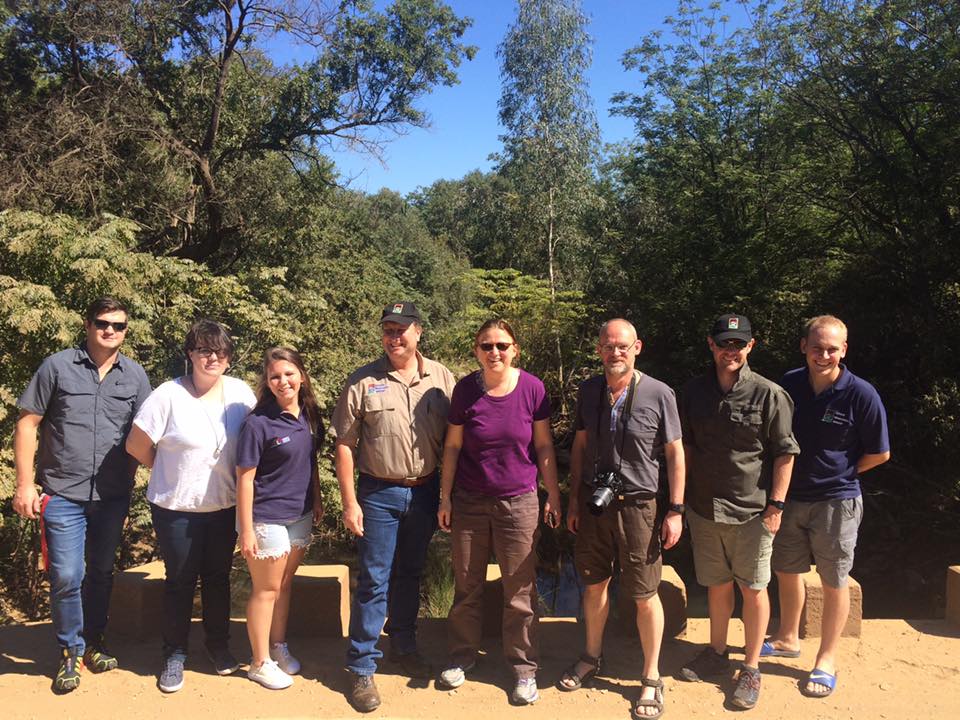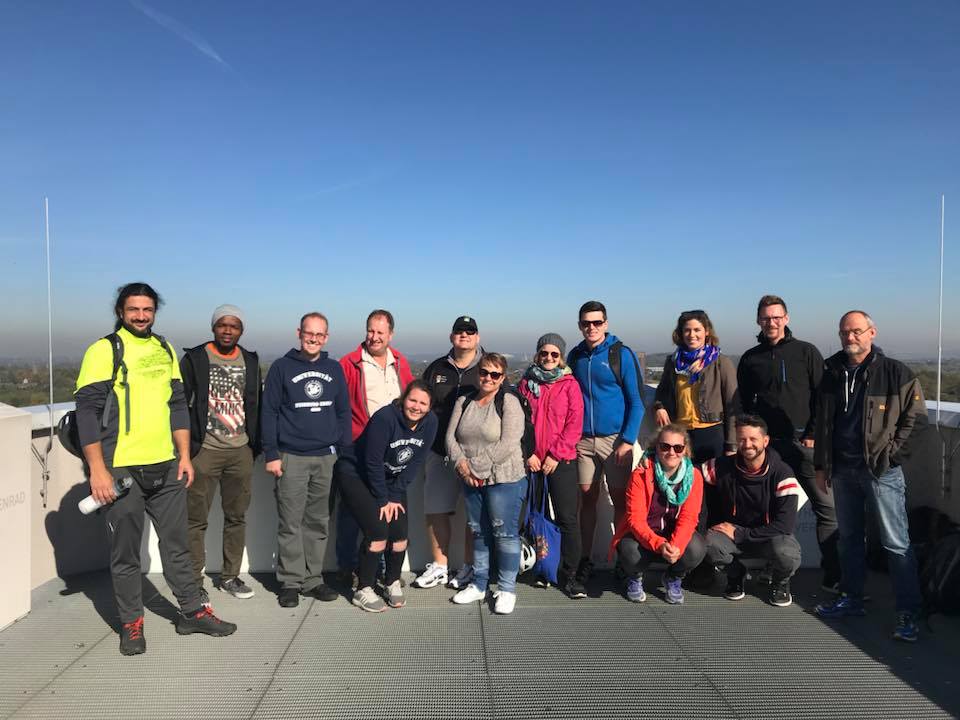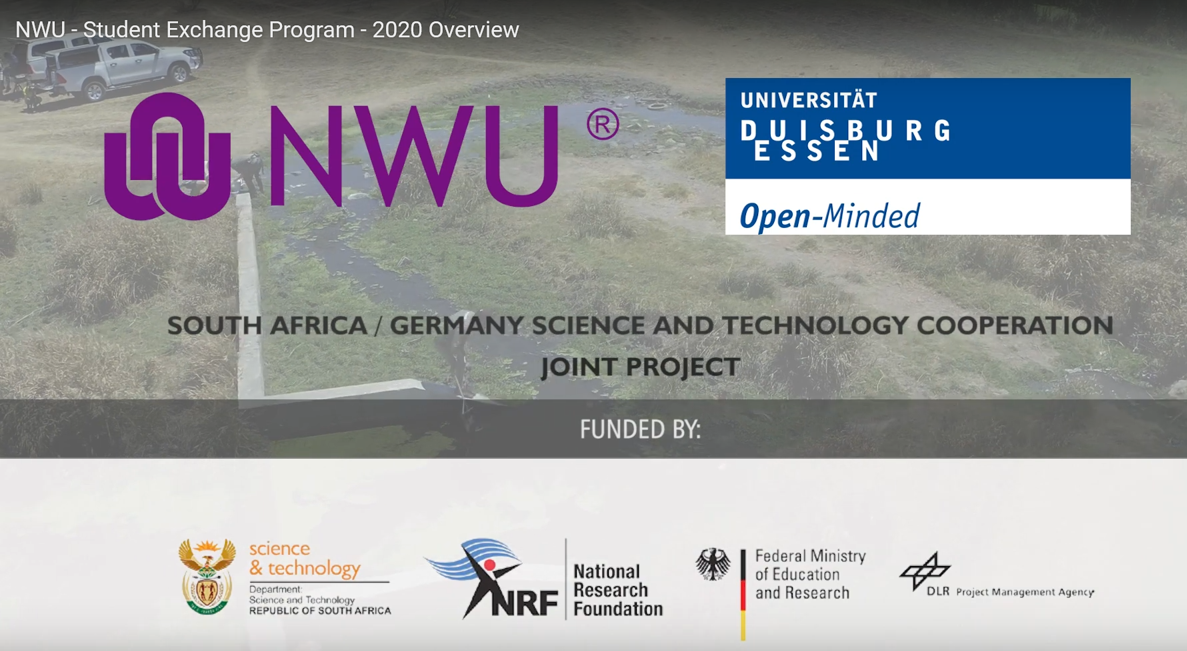In collaboration with:
![]()
![]()
![]()
![]()
Short video footage
German bilateral collaboration: platinum group elements in the Hex River system
The collaboration between the Water Research Group (WRG), North-West University, and the Aquatische Ökologie (Aquatic Ecology) Group, Universität Duisburg-Essen, was funded by the National Research Foundation (NRF) South Africa and the Federal Ministry of Education and Research (BMBF/PT-DLR) Germany. This collaboration was established to advance the understanding of the role and effects of platinum group elements (PGE) in aquatic systems, however, the most important aim of this bilateral project was expertise exchange between the two partner institutions and the chance to provide young researchers with the opportunity to learn from and work with international partners. The two institutions provided equipment and facilities to advance student training from fieldwork to laboratory analyses, while providing expertise in water and sediment quality assessment, as well as various biological assessment techniques (macroinvertebrates, fish and parasites). This amazing collaboration provided 15 students (seven South Africans, eight Germans) the opportunity to visit international laboratories and learn valuable scientific techniques, meet internationally established researchers and peers in their field, but also experience the different cultures and scenery.
With South Africa as the main supplier of PGE worldwide and some of the world’s most productive platinum (Pt) mines located on the banks of the Hex River, North West Province and the German collaborators with their internationally renowned expertise on PGE chemical analyses and exposure techniques, this collaboration between the two institutions were meant to be. Platinum group elements are primarily used as catalytic converters, which decreases harmful carbon monoxide and nitrous oxide emissions in automobile exhausts, while these elements are also widely used in several industrial and manufacturing processes (electronics, glass, petrochemical), as well as in the medical field (anti-cancer drugs, pacemakers). Even though South Africa is the leading producer of Pt, research on the exposure or effects of Pt mining activities on the aquatic ecosystems were limited. Therefore, the main aims of the project were to: 1) identify the role of PGE in the social-ecological health of the Hex River catchment, 2) gain valuable information on the bioavailability of PGE in aquatic systems from biomonitoring studies with different animals and artificial monitoring devices, 3) gain knowledge of the effects of PGE on different aquatic animals and identify sensitive organisms, and 4) determine the relative risk of PGE contaminations to aquatic organisms and humans of the South African mining area by using a novel risk assessment tool.


During the course of this collaboration (2017-2020) several laboratory and field exposures were assessed. Zebra mussels, Dreissena polymorpha, were exposed to a range of Pt concentrations (0.1 – 1000 μg/L) to assess the uptake and response to these Pt concentrations. For the first time it was demonstrated that Pt have the ability to increase the activity of antioxidant enzyme systems, as well as increased lipid peroxidation. The two highest concentrations led to overwhelmed antioxidant defence systems, followed by lethal effects at the highest concentration. Even though the highest concentrations are well above the concentrations found in the environment, it indicated that with an increase in Pt concentrations in the environment and the ability to accumulate in organisms, it can pose as a probable threat to various aquatic species. Artificial mussels (passive sampling devices) were validated in the laboratory and in the field, to determine whether it can be used as a reliable monitoring tool of bioavailable Pt and associated metals and, whether these sampling devices can be used as an alternative to living organisms. From the results it was found that the artificial mussels only represent the dissolved bioavailable metal fraction and cannot account for the fraction organisms obtain through their food. It was therefore recommended to use artificial mussels in conjunction with living bioindicators.
Different freshwater insects and crabs (aquatic macroinvertebrates) were assessed to see whether these organisms are able to show the extent of platinum and associated metal pollution in the Hex River. These insects play an important role in freshwater systems such as nutrient cycling and food sources for different fish species. It was found that snails, mayflies, midge larvae and aquatic earthworms had the highest metal concentrations in their bodies and that aquatic earthworms had Pt concentrations 55 times higher than previously recorded in studies completed around the world. Macroinvertebrate community structures were also altered from non-mining conditions to mining impacted conditions, whereby inhibiting the occurrence of sensitive species and promote the occurrence of highly tolerant species. Three fish species (Clarias gariepinus, Cyprinus carpio, Oreochromis mossambicus) from non-mining (Olifantsnek Dam) and mining impacted (Bospoort Dam) impoundments were assessed. The Pt concentrations in fish from the Hex River were 13-fold higher than Pt concentrations reported from urban systems around the world, while O. mossambicus (Mozambique tilapia) accumulated the highest metal concentrations compared to the other fish species. A high probability of adverse health effects to humans that consume these fish, were also noted for high concentrations of arsenic in both impoundments. Fish parasites (nematodes, cestodes) were also assessed for metal accumulation compared to their fish hosts. It was found that the fish hosts accumulated essential metals more readily, while the parasites accumulated the non-essential metals more readily from their hosts. Infected fish were also associated with lower metal concentrations compared to uninfected fish, while the parasites had significantly higher metal concentrations than their hosts. These results can indicate that parasites have the ability to detoxify the fish host from harmful metal concentrations and may even have positive effects on the host.
The results obtained during this collaboration greatly exceeded our expectations and resulted in several peer reviewed publications in high impact factor international journals, as well as several oral and poster presentations at national and international conferences. More publications are already submitted for review or are in the pipeline.

For more information and the full extent of the findings, please see the following publications:
Brand, S.J., Erasmus, J.H., Labuschagne, M., Grabner, D., Nachev, M., Zimmermann, S., Wepener, V., Smit, N.J., Sures, B. (2019). Bioaccumulation and metal-associated biomarker responses in a freshwater mussel, Dreissena polymorpha, following short-term platinum exposure. Environmental Pollution (IF: 6.792), 246: 69-78. https://doi.org/10.1016/j.envpol.2018.11.061.
Erasmus, J.H., Malherbe, W., Gerber, R., Weyl, O.L.F., Sures, B., Wepener, V., Smit, N.J. (2019). First record of Labeo capensis (Smith, 1841) in the Crocodile River (West) system: another successful non-native freshwater fish introduction in South Africa. African Journal of Aquatic Science (IF: 0.778), 44: 177-181. https://doi.org/10.2989/16085914.2019.1616529.
de Necker, L., Manfrin, A., Ikenaka, Y., Ishizuka, M., Brendonck, L., Van Vuren, J.H.J., Sures, B., Wepener, V., Smit, N.J. (2020). Using stable δ13C and δ15N isotopes to assess foodweb structures in an African subtropical temporary pool. African Zoology (IF: 1.436), 55:79-92. https://doi.org/10.1080/15627020.2020.1731331.
Schwelm, J., Kudlai, O., Smit, N.J., Selbach, C., Sures, B. (2020). High parasite diversity in a neglected host: larval trematodes of Bithynia tentaculata in Central Europe. Journal of Helminthology, (IF: 2.17), 94: e120. https://doi.org/10.1017/S0022149X19001093.
Yoneva, A., Kutcha, R., Smit, N.J. (2020). Ultrastructure of the uterus, embryonic envelopes and the coracidium of the enigmatic tapeworm Tetracampos ciliotheca (Cestoda: Bothriocephalidea) from African sharptooth catfish (Clarias gariepinus). Parasitology Research (IF: 2.289), 119: 847-858. https://doi.org/10.1007/s00436-019-06496-3.
Erasmus, J.H., Malherbe, W., Zimmermann, S., Lorenz, A.W., Nachev, M., Wepener, V., Sures, B., Smit, N.J. (2020). Metal accumulation in riverine macroinvertebrates from a platinum mining region. Science of the Total Environment (IF: 6.551), 703: 134738. https://doi.org/10.1016/j.scitotenv.2019.134738.
Erasmus, J.H., Wepener, V., Nachev, M., Zimmermann, S., Malherbe, W., Sures, B., Smit, N.J. (2020). The role of fish helminth parasites in monitoring metal pollution in aquatic ecosystems: a case study in the world’s most productive platinum mining region. Parasitology Research (IF: 2.289), 119: 2783-2798. https://doi.org/10.1007/s00436-020-06813-1.
Labuschagne, M., Wepener, V., Nachev, M., Zimmermann, S., Sures, B., Smit, N.J. (2020). The application of artificial mussels in conjunction with transplanted bivalves to assess elemental exposure in a platinum mining area. Water (IF: 2.524), 12: 32. https://doi.org/10.3390/w12010032.
Labuschagne, M., Zimmermann, S., Smit, N.J., Erasmus, J.H., Nachev, M., Sures, B., Wepener, V. (2021). Laboratory and field studies on the use of artificial mussels as a monitoring tool of platinum exposure in the freshwater environment. Environmental Sciences Europe (IF: 5.394), 33: 16. https://doi.org/10.1186/s12302-021-00461-7.
Rothe, L., Botha, T.L., Feld, C.K., Weyand, M., Zimmermann, S., Smit, N.J., Wepener, V., Sures, B. (2021). Effects of conventionally-treated and ozonated wastewater on mortality, physiology, body length, and behaviour of embryonic and larval zebrafish (Danio rerio). Environmental Pollution (IF: 6.792), 286: 11241. https://doi.org/10.1016/j.envpol.2021.117241.
Erasmus, A., Smit, N.J., Zimmermann, S., Nachev, M., Sures, B., Wepener, V. (2021). Metal and metalloid concentrations in the southern African endemic inter- and infratidal super klipfish, Clinus superciliosus, from the west and south coasts of South Africa. Marine Pollution Bulletin (IF: 5.553), 172: 112852. https://doi.org/10.1016/j.marpolbul.2021.112852.
Díaz-Morales, D.M., Erasmus, J.H., Bosch, S., Nachev, M., Smit, N.J., Zimmermann, S., Wepener, V., Sures, B. (2021). Metal contamination and toxicity of soils and river sediments from the world’s largest platinum mining area. Environmental Pollution (IF: 6.792), 286: 117284. https://doi.org/10.1016/j.envpol.2021.117284.
Erasmus, J.H., Lorenz, A.W., Zimmermann, S., Wepener, V., Sures, B., Smit, N.J., Malherbe, W. (2021). A diversity and functional approach to evaluate the macroinvertebrate responses to multiple stressors in a small subtropical austral river. Ecological Indicators (IF: 4.958), 131:108206. http://doi.org/10.1016/j.ecolind.2021.108206.

Last updated: February 2025
Comments on the content and accessibility, please contact: Anja Erasmus


